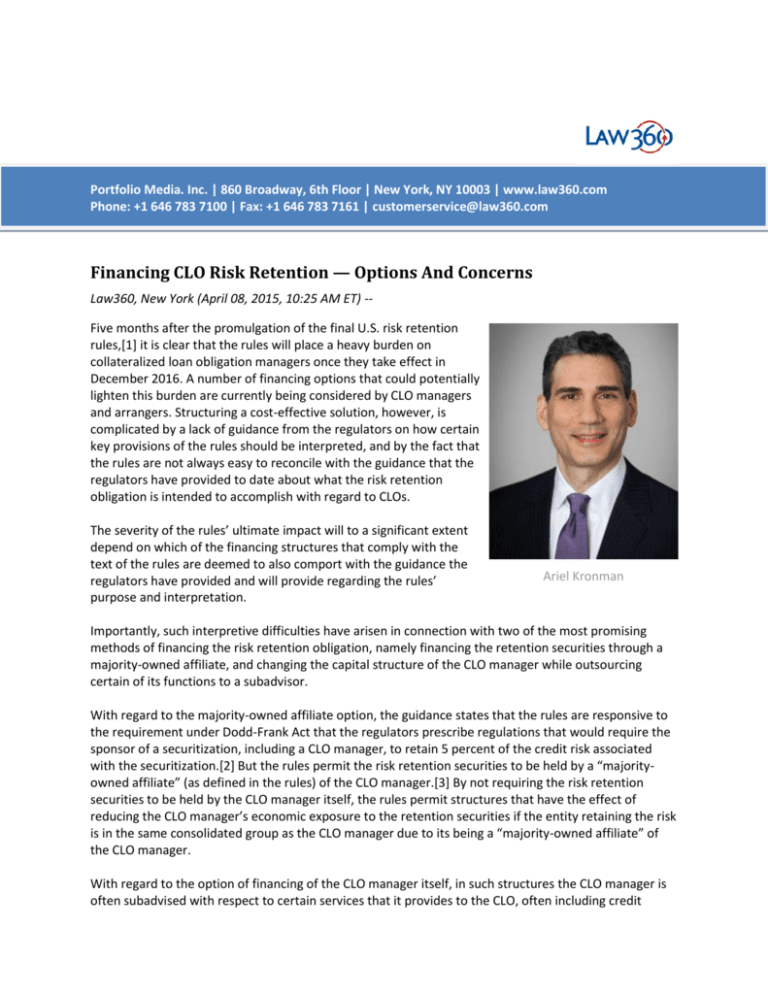Financing CLO Risk Retention
advertisement

Portfolio Media. Inc. | 860 Broadway, 6th Floor | New York, NY 10003 | www.law360.com Phone: +1 646 783 7100 | Fax: +1 646 783 7161 | customerservice@law360.com Financing CLO Risk Retention — Options And Concerns Law360, New York (April 08, 2015, 10:25 AM ET) -Five months after the promulgation of the final U.S. risk retention rules,[1] it is clear that the rules will place a heavy burden on collateralized loan obligation managers once they take effect in December 2016. A number of financing options that could potentially lighten this burden are currently being considered by CLO managers and arrangers. Structuring a cost-effective solution, however, is complicated by a lack of guidance from the regulators on how certain key provisions of the rules should be interpreted, and by the fact that the rules are not always easy to reconcile with the guidance that the regulators have provided to date about what the risk retention obligation is intended to accomplish with regard to CLOs. The severity of the rules’ ultimate impact will to a significant extent depend on which of the financing structures that comply with the text of the rules are deemed to also comport with the guidance the regulators have provided and will provide regarding the rules’ purpose and interpretation. Ariel Kronman Importantly, such interpretive difficulties have arisen in connection with two of the most promising methods of financing the risk retention obligation, namely financing the retention securities through a majority-owned affiliate, and changing the capital structure of the CLO manager while outsourcing certain of its functions to a subadvisor. With regard to the majority-owned affiliate option, the guidance states that the rules are responsive to the requirement under Dodd-Frank Act that the regulators prescribe regulations that would require the sponsor of a securitization, including a CLO manager, to retain 5 percent of the credit risk associated with the securitization.[2] But the rules permit the risk retention securities to be held by a “majorityowned affiliate” (as defined in the rules) of the CLO manager.[3] By not requiring the risk retention securities to be held by the CLO manager itself, the rules permit structures that have the effect of reducing the CLO manager’s economic exposure to the retention securities if the entity retaining the risk is in the same consolidated group as the CLO manager due to its being a “majority-owned affiliate” of the CLO manager. With regard to the option of financing of the CLO manager itself, in such structures the CLO manager is often subadvised with respect to certain services that it provides to the CLO, often including credit analytics. The guidance provided in the preamble to the rules states that third parties may not serve as “securitizers.”[4] It goes on to say that CLO managers are to be treated as “securitizers” because “[t]he agencies believe the final rule places risk retention responsibility on the parties most capable of ensuring and monitoring the credit quality of the assets collateralizing open market CLOs — the CLO manager or the lead arranger.”[5] What the effect, if any, of outsourcing credit analytics or any other CLO manager functions may have on a determination of who is the “securitizer” and who is a “third party” is not addressed in such guidance. Background Section 941(b) of the Dodd-Frank Act requires “securitizers” to retain 5 percent of the credit risk associated with an asset-based securities transaction, which term includes a CLO. Although the rules promulgated under that section effectively consider the “securitizer” of a CLO issuance to be its “sponsor,”[6] and define “sponsor” as a person who organizes a securitization and sells assets to the issuing entity,[7] guidance provided by the regulators in the preamble to the rules states that a CLO manager should be treated as a CLO’s sponsor even though it sources assets on behalf of a CLO issuer rather than sells assets to it.[8] The rules further provide that “5% of the credit risk” could be retained by holding either 5 percent of the CLO’s initial capital structure in the form of its lowest tranche of securities (“horizontal retention” or “equity retention”) or by holding 5 percent of each class of securities issued by the CLO (“vertical retention”).[9] Permitting risk to be retained in the form of a securitization vehicle’s equity is reasonable and intuitive — and is already a feature of many securitizations, including many CLOs, in which CLO managers and/or their affiliates often acquire a portion of the equity issued even though there is no current legal requirement for them to do so. However, equity retention under the rules would actually result in a sponsor bearing far more than 5 percent of the credit risk associated with a CLO, since a significant majority of a CLO’s securities are issued in the form of AAA and AA notes, and despite the issuance of thousands of CLOs over the years, no AAA or AA tranche has ever experienced a payment default. If this large body of historical data is any guide, credit losses in a CLO’s portfolio of assets will be borne in great part by the equity class, with a relatively small amount extending to the lower grade classes of debt, particularly the noninvestment grade classes. Equity retention, which, given the capital structure of many CLOs, would require the sponsor to retain around half of the equity class, would have the CLO manager bear far more than 5 percent of the losses on a CLO’s portfolio. Interpreting “sponsor” to include CLO managers that do not sell assets into securitizations but instead select them on behalf of the CLO issuer and its investors, and equating around half of the equity of a CLO with 5 percent of its “credit risk” results in a risk retention regime that imposes a significant financial burden on CLO managers. Traditional ABS sponsors originate assets, and use securitization as a means of financing those assets. So the effect of the rules on traditional ABS sponsors is that they may securitize no more than 95 percent of a portfolio that they originate. CLO managers, by contrast, do not originate assets, but simply perform investment management services.[10] For many CLO managers, acquiring 5 percent of the securities of each CLO that they manage could be accomplished only, if at all, by converting their business from that of an asset management company to that of a CLO investment fund that also engages in loan management.[11] At the interagency meeting held at the Fed on Oct. 22, 2014. in which the rules were adopted, then-vice chairman of the Fed Janet Yellen told Adam Ashcraft, senior vice president at the New York Fed and head of its structured products function, that her one concern regarding CLO risk retention was whether the market could adjust to the burden of acquiring risk retention securities. “It seems as though asset managers aren't structured to have the resources to be able to take on the risk retention,” she told him. She then asked him, “is it your sense from the conversations and research that you've done, that you think the market has the ability to adjust, so we won't see a severe contraction of credit in this area?” “I think we're fairly confident that the market will find a way to respond,” Ashcraft replied.[12] Below are some of the options and considerations involved in responding to the risk retention obligation. Investing in the CLO Manager Under the rules, CLO managers may finance risk retention securities by borrowing on a full-recourse basis, and may pledge the retention securities as security.[13] In the European CLO market, where risk retention rules have been in effect for two years already, some managers opting for vertical retention have been able to finance a majority of the investment grade portion of the risk retention securities. But going this route, a portion of the investment grade retention securities, and all of the noninvestment grade securities, would still need to find alternative financing. Morever, given the modest capitalization of many CLO managers, the rates at which they can borrow may not be particularly attractive. And since borrowing to buy risk retention securities will cause a CLO manager’s balance sheet to soon be dominated not by CLO management contracts but by CLO securities, including CLO equity, CLO managers may become worse credits over time, adversely affecting their ability to access the bank market. Accordingly, bank financing may not meet the retention securities financing needs of at least some CLO managers. For managers opting for equity retention, another source of funding could come from financing provided by hedge funds and other typical investors in CLO equity or mezzanine notes. The most straightforward way to accomplish this in a legally compliant fashion is probably the most challenging from an economic one, namely converting the CLO manager into a collective investment vehicle, either directly or through an affiliate — effectively turning it into a CLO equity fund that also has a loan management business. In such a structure, the current owners of the CLO manager would retain interests — in the form of securities or contractual rights — that would entitle them to something approximating the economics of CLO management, while investors would receive securities that receive the entity’s profit net of such management expense, namely something approximating the return on the CLO manager’s portfolio of retention securities. While a sponsor is prohibited from hedging its retention securities,[14] capital could in principle be raised each time a CLO closes and retention securities are purchased in a manner that would not constitute hedging. There are numerous issues to consider in evaluating this structure: One is whether its economics can be made attractive to an investor that has the option of investing instead in a CLO equity fund, which this structure largely resembles, though without any manager diversification. The most obvious source of additional return to an investor is the revenue stream otherwise payable to the CLO management team. But given the economies of scale that favor large asset managers who manage CLO equity funds, it is uncertain whether smaller and mid-size CLO managers have enough to offer investors out of their current economics to make this arrangement attractive to both sides. A second issue is that an investment in a CLO manager/fund likely would be less liquid than a direct investment in CLO mezzanine debt or equity, especially before the CLO manager/fund has achieved a certain size and track record. For investors with an option to simply invest in CLO equity or mezzanine securities, it is not clear how investing in a CLO manager could be made sufficiently attractive to compensate for the loss of liquidity. A third issue is that a CLO’s securities that are held by its manager are generally disregarded in certain votes regarding the manager’s removal or replacement, and so an investor investing in a manager/fund would not have a voting right that it would have had if it invested in CLO equity directly. Also, the manner in which “management” fees are extracted needs to be carefully structured. If payments are made because the CLO manager/fund is largely outsourcing management functions from the current management entity or its principals and paying a subadvisory or comparable fee for such services, there is a risk that the subadvisor rather than the nominal CLO manager/fund will be treated as the manager (sponsor) for regulatory purposes and that the retention securities will be considered held by an ineligible entity. This risk could perhaps be mitigated by structuring the nominal CLO manager/fund to qualify as a majority-owned affiliate of the “subadvisor,” because, as noted above, the rules permit retention securities to be held by a sponsor or by its majority-owned affiliate. However, in order for the CLO manager/fund to be treated as a majority-owned affiliate of the subadvisor, the subadvisor or an affiliate of the subadvisor will have to either own a majority of the CLO manager/fund’s equity, or have a “controlling financial interest” in the CLO manager/fund as determined under generally accepted accounting principles. In other words, the subadvisor or its affiliate will have to enjoy a certain degree of control and economics in the CLO manager/fund — perhaps including the right to vote on a refinancing of the CLO — and that degree will be dictated by the generally accepted accounting principles that the rules provide are to be used in determining whether an entity is a majority-owned affiliate of a sponsor. An arrangement in which the subadvisor is a majority-owned affiliate of the CLO manager/fund would work only if investors in the CLO manager/fund were willing to provide the subadvisor or its affiliate with the requisite amount of control and economics. Financing Individual Tranches of Retention Securities Another approach would be for the CLO manager to finance retention securities in a manner that affords the provider of financing with economics that relate primarily to the performance of a specific CLO rather than a return based on the business of the CLO manager overall. This, too, could in principle be executed in a number ways, with the securities issued to an investor by the CLO manager itself, or through a holding company or other affiliate. For any such approach to work, the securities will need to be attractive to investors who might otherwise invest in a CLO’s mezzanine debt or equity directly, as well as of course be sound as a regulatory matter. A primary regulatory sensitivity in such a structure is the prohibition on hedging the retention securities. The restriction on nonrecourse financing may also be of concern, as well the ability of a lender to foreclose on pledged retention securities. The rules prohibit a sponsor or its affiliates from entering into any arrangement, including issuing any security, if payments on the security or contractual right to payment created thereby is “materially related to the credit risk” of retention securities and the effect of the arrangement is to reduce the sponsor’s financial exposure to retention securities.[15] A pass-through certificate or participation interest in the retention securities would therefore appear to be prohibited, but an arrangement that did not reduce the CLO manager’s financial exposure to the retention securities could be compliant with the rules even if the cash flows to the third-party investor depend on the performance of the retention securities. For example, a note that also enjoys some performance-based economics in the form of additional interest might be structured to not constitute hedging provided that it was full recourse to the CLO manager. To mitigate the risk that what is offered to an investor is deemed an impermissible hedge of the credit risk associated with the retention securities, some CLO managers have considered establishing an SPV that would acquire the retention securities of a given CLO and finance the acquisition through the issuance of two classes of equity securities, or a class of equity and a class of debt that is full recourse to the SPV. The larger class of equity or the debt class, as applicable, would be purchased by the external provider of financing (the “senior investor”). The smaller, junior class of equity (or the sole equity class, if debt financing is used) would be acquired by the CLO manager or its affiliates, but the arrangement would be structured such that the SPV would be treated as a majority-owned affiliate of the CLO manager rather than the senior investor. As with the approach described above in which the CLO manager holds the retention securities and is a majority-owned affiliate of a subadvisor, the devil will be in the details of how to allocate control and economics in a manner that is acceptable to the CLO manager and the senior investor while not compromising the SPV’s status as a majority-owned affiliate of the CLO manager. In such a structure, the CLO manager might contribute to the SPV cash, as well, perhaps, as other assets, which may include its entitlement to its subordinate and incentive fees for the particular CLO. While there are many variations on financing risk retention securities through a majority-owned affiliate, in all such structures, the CLO manager (or its affiliate) either retains a majority of the SPV’s equity or has a controlling financial interest as defined under GAAP in the SPV. Provided that the majority-owned affiliate status is preserved, in addition to an interest coupon or preferred dividend, the senior investor might be capable of enjoying additional interest based on a CLO performance metric, as well as at least some of the call option value embedded in CLO equity (perhaps via a make-whole payment and/or stepped-up interest if a CLO is not refinanced). While the rules prohibit limited recourse borrowing to finance retention securities, whether by the retention holder or its affiliates, in the structure described, any borrowing is full recourse, albeit to the majority-owned affiliate of the CLO manager rather than the CLO manager itself. CLO managers who are concerned that this arrangement has the effect of reducing the CLO manager’s economic risk to an amount considerably less than 5 percent of the capital structure and might somehow be construed as impermissible hedging of their financial exposure to retention securities could guarantee the SPV’s obligations to the senior investor. CLO managers willing to issue a guarantee likely will want the guaranteed obligation to PIK (payment in kind), unless liquidity financing can be obtained on favorable terms. And any arrangement involving a majority-owned affiliate will need to address the possibility that an entity may cease to be a majority-owned affiliate due to a change in GAAP. Dual US/EU Solutions Another challenge facing CLO managers is how to achieve compliance with both the rules and the parallel regime promulgated in the European Capital Requirements Regulation (CRR). CLO managers may, in principle, be suitable entities to hold CLO retention securities in compliance with both the rules and the CRR, provided that they have the appropriate licenses to act as asset managers and invest in the retention securities in all relevant jurisdictions. In the EU, the CLO manager would likely act as “sponsor” as defined under the CRR, assuming it was an investment firm regulated under the CRR. Under both regimes, the CLO manager may obtain financing to acquire the retention securities subject to prohibitions on hedging or transferring the associated credit risk. A second approach currently under consideration by some CLO managers involves the use of an “originator” vehicle. Although the CRR does not provide that risk retention securities may be held by a majority-owned affiliate of a sponsor, it does allow for retention securities to be held not only by a CLO manager (as sponsor) but also by an “originator” that purchases the assets for its own account and sells a majority of a CLO’s debt portfolio to it. Accordingly, a vehicle that qualified as an originator under the CRR and a majority-owned affiliate of the CLO manager would also be compliant with both the rules and the CRR. —By Ariel Kronman, Weil Gotshal & Manges LLP Ariel Kronman is a partner in Weil's New York office. He has worked at a number of investment banks and hedge funds on Wall Street and in Asia, including as head of legal coverage of the collateralized debt obligation/CLO desk at Bank of America. Prior to rejoining Weil, Kronman was a managing director in the legal department at Bear Stearns. The opinions expressed are those of the author(s) and do not necessarily reflect the views of the firm, its clients, or Portfolio Media Inc., or any of its or their respective affiliates. This article is for general information purposes and is not intended to be and should not be taken as legal advice. [1] The complete text of the rules, as adopted by the Office of the Comptroller of the Currency, the Board of Governors of the Federal Reserve System, the Federal Deposit Insurance Corp., the U.S. Securities and Exchange Commission, the Federal Housing Finance Agency and the Department of Housing and Urban Development is available at https://www.fdic.gov/news/board/2014/2014-1021_notice_dis_a_fr.pdf. Page and citation references to the rule herein refer to the pages and citations of the preceding website address. [2] See Preamble to Rules, p. 77716. [3] See Rules, §_.3(a) (“Except as otherwise provided in this part, the sponsor of a securitization transaction (or majority-owned affiliate of the sponsor) shall retain an economic interest in the credit risk of the securitized assets in accordance with any one of §§ _.4 through __.10.”). [4] See Preamble to Rules, p. 77706, 77708 [5] See Preamble to Rules, p. 77659 [6] See Rules, §_.2 (“Securitizer means, with respect to a securitization transaction, either: (1) The depositor of the asset-backed securities (if the depositor is not the sponsor); or (2) The sponsor of the asset-backed securities.”) Broadly syndicated CLO transactions do not involve a depositor, and so only a “sponsor” could qualify as securitizer of a broadly syndicated CLO. [7] See id. (“Sponsor means a person who organizes and initiates a securitization transaction by selling or transferring assets, either directly or indirectly, including through an affiliate, to the issuing entity.”). [8] See Preamble to Rules, p. 77650. (stating, “the CLO manager will usually have sole discretion under the governing documents to select portions of tranches of syndicated commercial loans on the primary or secondary market to be acquired by the CLO in compliance with the investment guidelines” and, thus, “the agencies believe that the risk retention rules apply to CLOs because CLO managers clearly fall within the statutory definition of 'securitizer' set forth in Exchange Act section 15G”). [9] See Rules, §_.4(a)(1) and (2). [10] At least with respect to broadly syndicated CLOs. Middle-market CLOs often involve assets originated by the CLO manager or its affiliate, for whom the risk retention requirement may be less disruptive than for managers of broadly syndicated CLOs. [11] The rules provide for options to satisfy the CLO risk retention requirements other than by having the CLO manager acquire the retention securities, but for most CLOs, and particularly broadly syndicated CLOs, these are not practical and are therefore not addressed in this article. [12] Bd. of Governors of the Fed. Reserve Sys., Transcript of Open Board Meeting, 13 (Oct. 22, 2014), available at http://www.federalreserve.gov/mediacenter/files/open-board-meeting-transcript20141022.pdf. [13] See Rules, §_.12(e). It remains unclear how risk retention securities could be foreclosed upon given the restriction on their transfer. [14] See id. §_.12(b) [15] See id. §_.12(b). All Content © 2003-2015, Portfolio Media, Inc.








